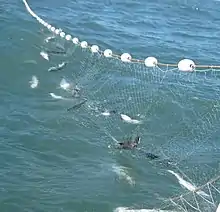The sustainable yield is a form of sustainability that refers to the maximum harvest that does not deplete or over-harvest where the renewable resource can not grow back.[1] In the simplest terms, sustainable yield is the largest amount of resource that humans can take or use without causing damage or allowing for a decline to happen in the specific population. In more formal terms, the sustainable yield of natural capital is the ecological yield that can be extracted without reducing the base of capital itself, i.e. the surplus required to maintain ecosystem services at the same or increasing level over time. The term only refers to resources that are renewable in nature as extracting non-renewable resources will always diminish the natural capital. The sustainable yield of a given resource will generally vary over time with the ecosystem's needs to maintain itself, e.g. a forest that has recently suffered a blight or flooding or fire will require more of its own ecological yield to sustain and re-establish a mature forest. While doing so, the sustainable yield may be much less. The term sustainable yield is most commonly used in forestry, fisheries, and groundwater applications.
A sustainable yield is calculated by the carrying capacity divided by 2.[2] At half of the carrying capacity, the population can be harvested and quickly recover, allowing for more resources. Although this calculation seems easy, it is not because it is difficult to calculate the carrying capacity of a population in nature since it is almost always based on estimations.
Importance
Understanding sustainable yield is essential to nature since it indicates how much a population can produce and what humans can glean from without causing fundamental problems in the specie's population. If the population is harvested above its maximum sustainable yield, it can eventually risk extinction.[3]
Forestry
Sustainable yield is an important component of sustainable forest management. In the forestry context it is the largest amount of harvest activity that can occur without degrading the productivity of the stock. The idea of sustainable yield of forests had shifted focus from only output, to include maintaining production capacity and maintaining the natural renewal capacity of forest vegetation.[4] One of the first federal written laws to warrant that future generations will have a sufficient wood supply and regulate the wood harvest rate was the O & C Act.[5] The O & C Act is a positive environmental impact since it helps maintain a viable, sustainable yield, and it ensures that trees will continue to be a significant part of the natural landscape everywhere and continue to supply wildlife habitats, carbon storage, and recreational activities.
Fishery

This concept is important in fishery management, in which sustainable yield is defined as the number of fish that can be extracted without reducing the base of fish stock, and the maximum sustainable yield is defined as the amount of fish that can be extracted under given environmental conditions.[6] In fisheries, the basic natural capital or virgin population, must decrease with extraction. At the same time productivity increases. Hence, sustainable yield would be within the range in which the natural capital together with its production are able to provide satisfactory yield.[7] It may be very difficult to quantify sustainable yield, because every dynamic ecological conditions and other factors not related to harvesting induce changes and fluctuations in both, the natural capital and its productivity.[6]
Groundwater Application
In the case of groundwater there is a safe yield of water extraction per unit time, beyond which the aquifer risks the state of overdrafting or even depletion. Depletion of an aquifer, or a decline in groundwater levels has the potential to cause land subsidence which can cause sinkholes.[8] In order to calculate this safe yield of water extraction in the area, a lot of considerations need to be taken into account. The first is the water budget, figuring out and understanding where water is used by humans, getting recharged, and being lost due to possible maintenance issues and natural phenomena. Another consideration is changing technology. Technology allows for possible gains in supply, for example, desalination technology, turning saltwater into drinking water. The other considerations include temporal, spatial, and monetary aspects, which all cause changes in the water system that change the amount of usable water.[9]
See also
- Sustainable yield in fisheries
- Maximum sustainable yield
- Hans Carl von Carlowitz, who pioneered the mathematics behind sustained yield with his 1713 treatise
References
- ↑ "Sustainability | Description, Theories, & Practices | Britannica". www.britannica.com. Retrieved 2023-05-06.
- ↑ Takashina, Nao; Mougi, Akihiko (October 2015). "Maximum sustainable yields from a spatially-explicit harvest model". Journal of Theoretical Biology. 383: 87–92. arXiv:1503.00997. Bibcode:2015JThBi.383...87T. doi:10.1016/j.jtbi.2015.07.028. PMID 26254215. S2CID 5211753.
- ↑ PEW (April 2012). "MSY - Maximum Sustainable Yield" (PDF). pewtrusts.org. Retrieved 2023-05-01.
- ↑ Wiersum, K. Freerk (May 1995). "200 years of sustainability in forestry: Lessons from history". Environmental Management. 19 (3): 321–329. Bibcode:1995EnMan..19..321W. doi:10.1007/BF02471975. ISSN 0364-152X. S2CID 153325794.
- ↑ "Sustained Yield Forestry". Association of O&C Counties. Retrieved 2023-05-07.
- 1 2 Ricker, W.E. (1975). "Computation and Interpretation of Biological Statistics of Fish Populations". Bulletin of the Fisheries Research Board of Canada. 191.
- ↑ Reynolds, John D.; Mace, Georgina M.; Redford, Kent H.; Robinson, John G. (2001-10-18). Conservation of Exploited Species. Cambridge University Press. ISBN 978-0-521-78733-8.
- ↑ "Land Subsidence | U.S. Geological Survey". www.usgs.gov. Retrieved 2023-05-07.
- ↑ Maimone, Mark (2004). "Defining and Managing Sustainable Yield" (PDF). Ground Water. 42 (6): 809–814. Bibcode:2004GrWat..42..809M. doi:10.1111/j.1745-6584.2004.tb02739.x. PMID 15584295. S2CID 29594099.